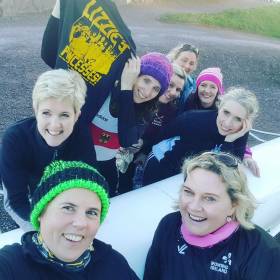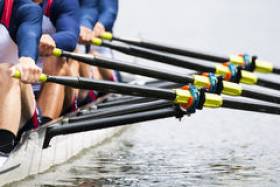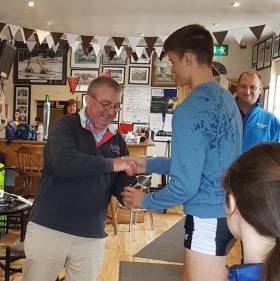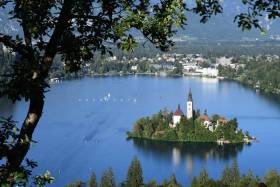Displaying items by tag: Shandon
#Rowing: Shandon’s intermediate eight were the fastest crew at the Metropolitan Regatta today. Commercial’s intermediate eight scratched, but UCD’s club one eight gave the young Corkmen a good race – until the final few hundred metres, when Shandon flew away. All of the Shandon crew are junior 18 athletes.
As had been the case in the first session, young rowers came home first in race after race in the superb conditions. Lara Brown of New Ross added the Division One single sculls title to the doubles win she had recorded with Shona Tierney.
Metropolitan Grand League Regatta, Blessington, Saturday (Selected Results; course length between 1750 and 1800m)
Men
Eight – Division One: Shanddon (intermediate) 4:57.91, 2 UCD (club one) 5:02.20. Div Two: Neptune (club two) 5:40.496.
Four – Div One: Commercial A (sen) 5:36.26. Four, coxed – Div One: 1 Commercial (sen) 5:55.01, 2 Shandon (jun 18A) 5:55.99, 3 Commercial (inter) 5:56.41; 5 UCD (club one) 6:02.82. Div Two: UCD A (club two) 5:50.77, 2 Shandon (jun 18B) 5:57.32
Pair – Div One: Commercial (inter) 6:07.65, 2 Commercial (sen) 6:14.6. B Final: 2 Castleconnell 6:25.78; 4 Belfast RC (club one) 6:43.92.
Sculling, Quadruple – Div Two, coxed: Shandon (jun 18B) 5:53.59, 2 Neptune (nov) 5:56.17, 3 Neptune (club two) 5:56.73.
Double – Div One: Castleconnell (jun 18A) 5:47.98; 6 Belfast RC (club one) 6:18.11. Div Two: Cappoquin (club two) 6:03.10; 2 Neptune (jun 18B) 6:03.44. B Final: Commercial C 6:44.69. Single – Div One: Shandon (J Dorney; jun 18A) 6:34.78, 2 St Michael’s (D O’Connor; sen) 6:37.81. B Final: Three Castles (T McKnight; inter) 6:47.52; 5 Commercial (J Casey; club one) 7:11.88. Div Two: Neptune (T Orlic; jun 16) 6:47. 76, 2 Clonmel (O’Donnell; club two) 6:49.48, 3 St Michael’s (O’Gorman; jun 18B) 7:00.84.
Women
Eight – Div Two: UCD (club two) 5:57.43; 4 Commercial (jun 16) 6:39.69. Four, coxed – Div Two: Neptune (club two) 6:56.77.
Pair – Div One: Castleconnell (jun 18) 7:14.24.
Sculling, Quadruple – Div Two, coxed: Commercial (jun 16) 6:51.87, 2 Neptune (club two) 6:54.06, 3 Fermoy (nov) 6:54.57; 6 Commercial (jun 18B) 7:49.09.
Double – Div One: New Ross (jun 18A) 6:43.13; 3 Neptune (club one) 6:48.66; 4 St Michael’s (sen) 7:05.97. Div Two: Carlow (jun 16) 7:11.58, 2 Neptune (club two) 7:36.47.
Single – Div One: New Ross (S Tierney; jun 18A) 7:06.03; 3 Garda (J Ryan; inter) 7:13.48. Div Two: Neptune (J Poh; club two) 7:18.24; 3 Three Castles (E Irwin; jun 16) 7:33.89.
Commercial and Shandon Shine in the Sun at Metro Regatta
Rowing: Commercial won the Division One coxed and coxless fours and the Division One pairs (through intermediates Charlie Cunningham and Lorcain Cameron), while 17-year-old Jack Dorney took the men’s Division One single sculls at the refixed Metro regatta at Blessington today.
The day could hardly have been better for rowing, but the entry was thin because of clashes with exams and other events. Young competitors shone: the women’s Division One pair A Final was made up entirely of junior 18 crews, with Castleconnell the clear winners; the New Ross’s junior 18 crew of Shona Tierney and Lara Brown were the top women’s double scull and Tristan Orlic of Neptune, who is 16, won Division Two of the men’s single single sculls.
Metropolitan Regatta, Blessington, Saturday
Men
Eight – Div Two: Neptune (club two) 5:40.496.
Four – Div One: Commercial A (sen) 5:36.26. Four, coxed – Div One: 1 Commercial (sen) 5:55.01, 2 Shandon (jun 18A) 5:55.99, 3 Commercial (inter) 5:56.41; 5 UCD (club one) 6:02.82.
Pair – Div One: Commercial (inter) 6:07.65, 2 Commercial (sen) 6:14.6. B Final: 2 Castleconnell 6:25.78; 4 Belfast RC (club one) 6:43.92.
Sculling, Single – Div One: Shandon (J Dorney; jun 18A) 6:34.78, 2 St Michael’s (D O’Connor; sen) 6:37.81. B Final: Three Castles (T McKnight; inter) 6:47.52; 5 Commercial (J Casey; club one) 7:11.88. Div Two: Neptune (T Orlic; jun 16) 6:47. 76, 2 Clonmel (O’Donnell; club two) 6:49.48, 3 St Michael’s (O’Gorman; jun 18B) 7:00.84
Women
Four, coxed – Div Two: Neptune (club two) 6:56.77.
Sculling, Quadruple – Div Two, coxed: Commercial (jun 16) 6:51.87, 2 Neptune (club two) 6:54.06, 3 Fermoy (nov) 6:54.57; 6 Commercial (jun 18B) 7:49.09.
Double – Div One: New Ross (jun 18A) 6:43.13; 3 Neptune (club one) 6:48.66; 4 St Michael’s (sen) 7:05.97. Div Two: Carlow (jun 16) 7:11.58, 2 Neptune (club two) 7:36.47.
Single – Div One: 1 Castleconnell (jun 18) 7:14.24.
Carlow Regatta Basks in Perfect Weather
#Rowing: Clubs from Coleraine to Shandon competed at the sun-graced Carlow Regatta, and a Commercial crew won the men’s eight. The two-day event was a chance for young rowers to test themselves. The host club proved strongest in some of the biggest races. On Saturday, Carlow won the men’s and women’s club two quadruples and doubles and the women’s club two single. The men’s club one single went to Muckross. On Sunday, the Carlow women’s junior 16 eight, quad and double won, as did the men’s junior 16 double.
Carlow Regatta, Selected Results
Saturday
Men
Eight – Sen: Commercial. Four – Masters: Waterford, Belfast BC, Neptune, Commercial, Galway.
Sculling, Quadruple – Club Two: Carlow. Jun 18B: Three Castles. Masters: Offaly.
Double – Club Two: Carlow. Jun 18B: Three Castles. Masters: Shandon B.
Single – Club One: Muckross. Club Two: Shandon B. Masters: Athlone (Gallen)
Women
Sculling, Quadruple – Club Two: Carlow. Jun 18A: Carlow A. Junior 18B: Carlow. Masters: Athlone.
Double – Club Two: Carlow A. Jun 18A: Carlow. Jun 18B: Graiguenamanagh.
Single – Club Two: Carlow (Corcoran). Jun 18A: Carlow (Scully) Jun 18B: Muckross (Coffey). Masters: Graiguenamanagh (Murray).
Sunday
Men
Sculling, Double – Jun 16: Carlow
Women
Eight – Jun 16: Carlow.
Sculling, Quadruple – Jun 16: Carlow. Double – Jun 16: Carlow.
#Rowing: Commercial finished second to Leander in the men’s Championship Eights at London Metropolitan Regattta at Dorney Lake today. It was one of a string of good results for Irish clubs. NUIG and Tribesmen shone and teamed up to win the women’s Championship coxed four. UCC – who took second in the Championship single sculls through Ronan Byrne – also excelled. Trinity, the University of Limerick, Shandon and Castleconnell also had wins.
London Metropolitan Regatta, Dorney Lake (Irish interest; selected results, winners unless stated)
Men
Eight – Championship: 1 Leander 5:49.90, 2 Commercial 5:52.74.
Four – Championship: 3 Commercial 6:12.20. Tier Two: Shandon.
Four, coxed – Tier Three: Tribesmen 6:32.26. Academic, Tier Two: NUIG.
Pair – Tier Two: UCC 7:14.93.
Double Sculls – Championship: 2 UCC (R Byrne, H Sutton) 6:32.50. Tier Two: Castleconnell 6:42.50.
Single Sculls – Championship: 2 UCC (R Byrne) 7:03.99. Tier Two: Univ of Limerick (K Mannix) 7:18.36. Tier Three: St Michael’s (D O’Connor).
Women
Eight – Club, Tier Two: NUIG/Tribesmen 6:50.64. Academic, Tier Two: Trinity 6:57.77.
Four – Academic, Tier Two: Trinity 7:08.62.
Four, coxed – Championship: NUIG/Tribesmen 7:20.88. Tier Four: Univ of Limerick.
Pair – Championship: 2 Commercial (H O’Neill, R Morris) 7:46.57. Tier Two: NUIG 7:39.84.
Double Sculls – Championship: 3 London/Skibbereen (M Jackson, N Long) 7:28.48.
#Rowing: Jack Dorney was an impressive winner of the Junior 18 men’s single sculls final at the Ireland Assessment at the National Rowing Centre today. The Shandon man moved into a clear lead by the 1500 metre mark and won well from Jack Keating of Carlow, who finished well.
Odhran Donaghy and Nathan Timoney of Enniskillen won the Junior men’s pairs final from Sam O’Neill and William Ronayne of Shandon, who gave them a good battle to the line.
The Fermoy women’s junior pair of Gill McGirr and Eliza O’Reilly also won well in the women’s junior pair, while Aoibhinn Keating of Skibbereen won an exciting final of the Junior women’s single.
Cork and Shandon In Form at Muckross Head
#Rowing: Cork Boat Club’s intermediate eight proved the fastest crew at the Muckross Head of the River at the National Rowing Centre. Shandon, who had a set of good results, saw their eight finish just five seconds off that pace – and their junior 18 quadruple took just nine minutes and 48 seconds to cover the course, placing them seventh overall. Justin Ryan of Skibbereen was the fastest single sculler.
The adult women’s ranks were thinner in numbers. Monika Dukarska was the fastest single sculler. A masters women’s crew from Lady Elizabeth and Dublin University Ladies Boat Club won: it featured well-known names, including former internationals Vanessa Lawrenson and Heather Boyle.
Muckross Head of the River – Selected Results
Overall: 1 Cork BC intermediate eight 9 mins 20 sec, 2 Shandon inter eight 9:25, 3 UCC senior quadruple 9:35.
Men, Eight – Intermediate: Cork 9:20. Club One: UCC 9:35. Club Two: UCC 9:44. Jun 16: Fermoy 10:35. Masters: Castleconnell 13:25.
Four – Sen: Shandon 9:56. Inter, coxed: Skibbereen 10:36. Club One: UCC 10:33. Jun 18, coxed: Presentation Col (D Murphy) 11:07
Pair – Sen: Skibbereen 10:54. Jun 18: Shandon 10:55.
Sculling, Quadruple – Sen: UCC 9:35. Club One, coxed: UCC 13:05. Club Two, coxed: Workmen’s 11:05. Masters, coxed: Clonmel 13:26. Jun 18: Shandon 9:48. Jun 16, coxed: Lee 10:56.
Double – Sen: UCC 11:33. Inter: UCC 10:37. Club One: Shandon 11:09. Jun 18: Skibbereen 11:11. Jun 16: Shandon 11:28.
Single – Sen: Skibbereen (J Ryan) 11:26. Inter: Castleconnell (P Silke) 12:00. Club One: Castleconnell 12:15. Club Two: Cork (R Povey) 12:16. Jun 18: Shandon (E Gaffney) 11:39. Jun 16: Tralee (B Winde) 12:57. Masters (H, adjusted): Lee Valley 13:40 (11:36).
Women,
Eight – Club One: Lee Valley 13:08. Club Two: Shandon 11:12. Jun 16: Muckross 12:28. Masters: Lady Elizabeth, Trinity 12:35.
Four – Sen: Skibbereen 11:36. Inter, coxed: Skibbereen 12:53. Club Two, coxed: Cork 12:22.
Pair – Sen: UCC/Skib 11:58.
Sculling, Quadruple - Sen: Workmen’s 10:50. Club One, coxed: Fermoy 12:14. Club Two, coxed: Lee 12:35. Jun 18: Workmen’s 11:12. Jun 16, coxed: Lee 12:29.
Double – Sen: Cork 11:41. Club One: Workmen’s 12:00. Jun 18: Workmen’s 11:49. Jun 16: Killorglin 12:19.
Single – Sen: Killorglin (M Dukarska) 11:54. Inter: Skibbereen (L Heaphy) 13:09. Club One: Lee Valley 13:08. Club Two: Killorglin (E O’Donovan) 13:35. Jun 18: Kenmare (E Crowley) 13:19. Jun 16: Killorglin (R O’Donoghue) 13:19. Masters: Clonmel (F, adjusted) 14:54 (13:26)
Cork Boat Club and UCC Take Good Wins at Skibbereen Head
#Rowing: The big numbers – up 100 on last year – and good weather made for a successful Skibbereen Head of the River at the Marina. Cork Boat Club’s intermediate eight set a fast time of nine minutes 19 seconds for the course. UCC also had a good day, with Ronan Byrne the fastest time in a senior single. Skibbereen and Shandon also had a set of good wins.
Skibbereen Head of the River (Selected Results; winners)
Head One:
Men
Sculling,
Single – Senior: UCC (R Byrne) 11 min 24 sec. Inter: UCC (D Larkin) 11:50. Club: UCC (H Sutton) 11:58. Jun 18A: Shandon (E Gaffney) 11:49. Jun 16: Shandon (D Cosgrave) 12:02. Masters: Cork (B Crean) 12:45.
Women
Pair – Sen: UCC/Skibbereen 11:49. Jun 18A: Shandon 13:33.
Head Two
Men
Four – Sen: Shandon 10.15. Sen, coxed: Skibbereen 10:46. Club One, coxed: Cork 11:10. Jun 18, coxed: Shandon 10:56. Jun 16, coxed: Shandon 11:35. Masters, coxed: Muckross B 11:14.
Women
Eight – Club One: UCC 11:07
Sculling, Double – Sen: Skibbereen 12:08. Inter: Cork A 12:21. Jun 18A: Workman’s 12:10. Jun 16: Lee 12:27.
Head Three
Men
Sculling, Quad – Sen: UCC 9:54. Inter: St Michael’s 10:29. Jun 18A: Shandon 9:58. Jun 16, coxed: Skibbereen 11:20.
Women
Sculling
Single – Inter: Skibbereen (E Hegarty) 12:46. Club One: Workman’s (S Burns) 13:09. Jun 18: Workman’s (C Browne) 12:52. Jun 16: Muckross (N Coffey) 14:23.
Head Four
Men,
Eight – Sen: UCC 9:34. Inter: Cork 9:19. Club One: Cork 10:00. Jun 18: Cork 11:00.
Sculling, Double – Club One: Shandon A 11:16. Jun 18A: Lee 10:55. Jun 16: Shandon 10:24.
Women
Four – Sen: Skibbereen 11:43. Inter: Shandon 11:55.
Head Five
Men
Pair – Sen: Skibbereen 11:06. Inter: Shandon B 11:00. Jun 18A: Shandon 11:03.
Women
Sculling, Quadruple – Club One, coxed: Workman’s 11:08. Jun 18A: Lee 10:57.
Rolling Head
Men
Sculling,
Single – Sen: Skibbereen (A Burns) 11:30
Inter: Skibbereen (K Mannix) 11:27.
Jun 18A: Killorglin (J McCarthy) 11:35.
Women
Four – Sen: Skibbereen 11:42
Pair – Sen: UCC/Skibbereen 11:37.
Dorney and Cremen Top Rankings at Cork Sculling Ladder Trial
#Rowing: Jack Dorney of Shandon Boat Club was the fastest at the Cork Sculling Ladder time trial at the Marina. More than 170 single scullers participated on Sunday in the 46th running of the event, which is sponsored by Argos Fire and Safety Ltd and BioAugmentation Systems Ltd. Dorney won in a time of seven minutes and 7.2 seconds. Three other Shandon scullers filled the next three spots: Alex Byrne, Stephen O’Sullivan and Eoin Gaffney.
Margaret Cremen, who won last last year, was again the fastest woman – the Lee Rowing Club competitor finished 10th overall; Cork Boat Club’s Lisa Dilleen was the next fastest woman. Conditions on the river were calm.
The 2017-2018 Cork Sculling Ladder continues until April 1st.
Cork Sculling Ladder, Time Trial, October 8th. Selected Results:
- Jack Dorney, Shandon Boat Club. 7 min 07.2 sec
- Alex Byrne, Shandon Boat Club. 7:15.8
- Stephen O’Sullivan, Shandon Boat Club. 7:17.7
- Eoin Gaffney, Shandon Boat Club. 7:18.5
- Cian O’Sullivan, Cork Boat Club. 7:25.1
10. Margaret Cremen, Lee Rowing Club. 7:37.9
23. Lisa Dilleen, Cork Boat Club. 8:06.3 (8:07.6)
31. Aoife Lynch, Lee Rowing Club. 8:19.6
Irish Crews Win at World Masters Regatta
#Rowing: Irish composite crews had good wins on the first day of the World Masters Regatta in Bled in Slovenia. The Irish B eight (average age 36 or more), which is formed from six clubs won. Two fours in the E class (average age 55 or more) also won – the Galway/Neptune combination by just .26 of a second. The decision was initially given to their German opponents.
World Masters Regatta, Bled, Slovenia, Day One (Selected Results; Irish interest; all heats of 1,000 metres, winners only)
Men
Eight, B (avg 36 or more) – Heat Five: Galway, Commercial, Shandon, Clonmel, Neptune, Cork 3:05.51.
Four, E (avg 55 or more) – Heat One: Galway, Neptune 3:26.26.
Heat Four: Waterford, Neptune, Commercial, Belfast BC 3:28.1
NUIG Women's Eight Impress At Metropolitan Regatta
#Rowing: Irish crews had a very successful second day at the Metropolitan Regatta at Dorney Lake. Monika Dukarska of Killorglin and the Skibbereen double of Denise Walsh and Aoife Casey won in the top single and double sculls races, but other crews also impressed. NUIG’s women’s eight finished third in the A Final in Tier One – the crew, which has a number of novice rowers, had also taken third in the morning time trial. Trinity, UCC, Shandon, Galway, Cork and UCD were amongst the crews which also came away with encouraging results over the weekend.
Metropolitan Regatta, Dorney Lake, Day Two (Selected Results; Irish interest)
Men
Eights – Tier One, Final B: 2 NUIG A, 3 UCD (A). Final C: 1 Trinity 6:07.65. Final D: 2 UCD. Final F: 1 NUIG (B) 6:25.61. Final I: 2 Trinity (D), 3 UCD (C).
Four – Tier Three Final: 1 UCC 6:36.53.
Four, coxed – Championship Final: 3 NUIG (B).
Pair – Tier Two Final: 2 UCC
Sculling, Double
Tier Two Final: 2 Shandon
Women
Eight – Tier One – Final A: 3 NUIG (A). Final B: 2 Commercial. Final C: 3 Galway. Final D: 2 NUIG.
Four, coxed – Tier Three: 3 Galway Rowing Club.
Pair - Tier One Final: 2 Cork (G Collins, L Dilleen)
Sculling, Double – Tier One Final: 1 Skibbereen 7:17.56.
Single – Tier One: 1 Killorglin (M Dukarska); 3 UCD (A Crowley).


































































